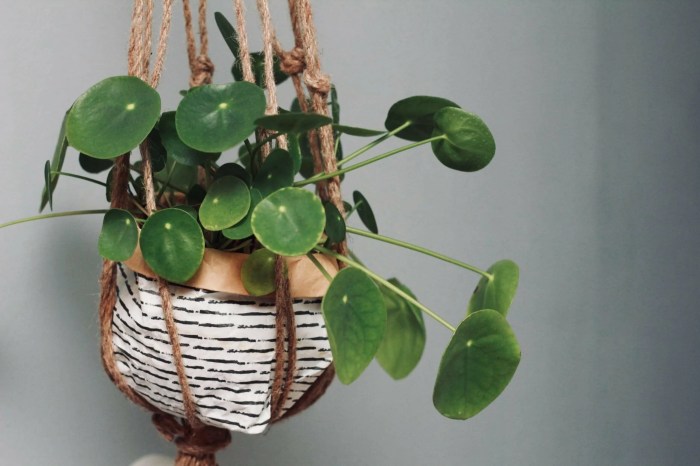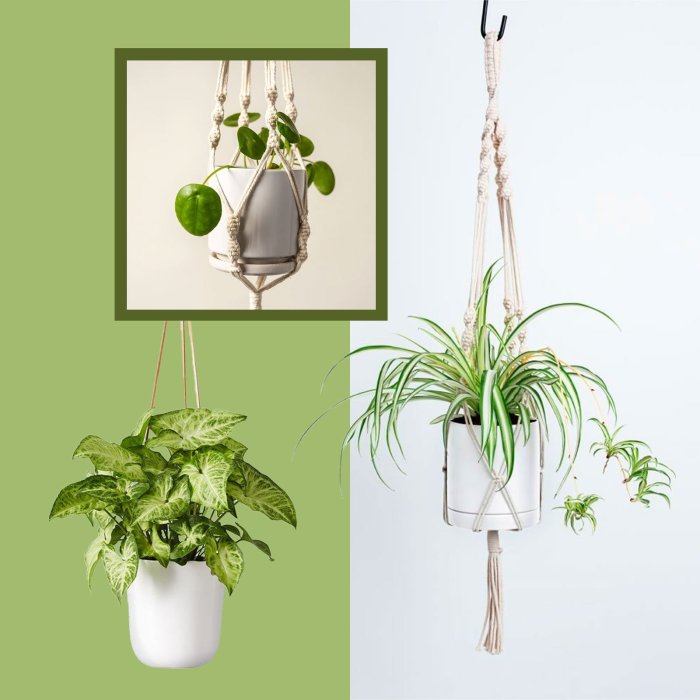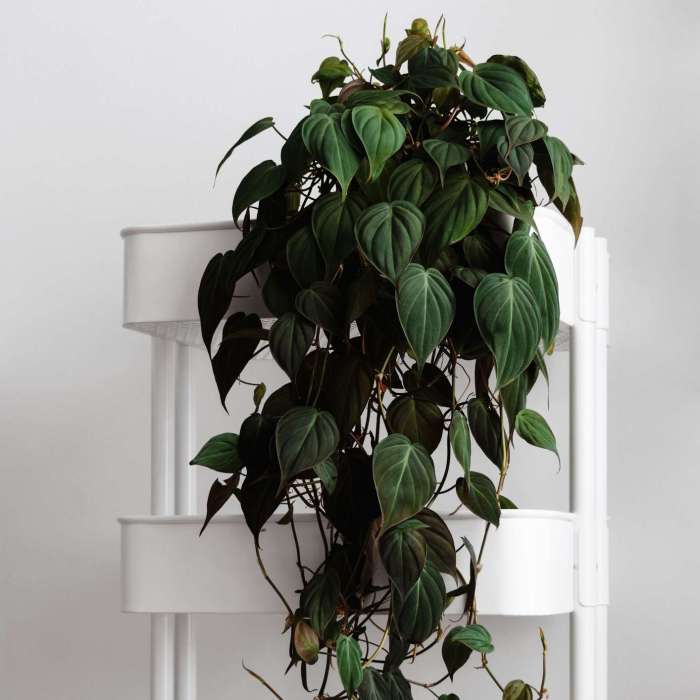Hanging houseplants are captivating the world of interior design, offering a unique blend of beauty and functionality. Their graceful presence not only adds aesthetic charm but also purifies the air, creating a healthier and more inviting living space.
From air-purifying wonders to creative display ideas, this comprehensive guide explores everything you need to know about hanging houseplants, empowering you to create a thriving indoor oasis.
Benefits of Hanging Houseplants

Hanging houseplants offer numerous advantages, including improving indoor air quality and creating a more aesthetically pleasing environment.
These plants are known for their air-purifying qualities, as they absorb toxins and pollutants from the air. Some effective air-purifying plants include spider plants, peace lilies, and snake plants. These plants help to remove harmful substances such as formaldehyde, benzene, and trichloroethylene, which can be emitted from furniture, cleaning products, and other household items.
Impact on Humidity Levels
Hanging houseplants can also help to regulate humidity levels in a room. By releasing water vapor into the air, they can increase humidity, which can be beneficial for people with respiratory problems or dry skin. Higher humidity levels can also help to reduce the spread of airborne viruses and bacteria.
Choosing the Right Hanging Houseplants
Selecting the perfect hanging houseplants for your home involves careful consideration of various factors. These include light requirements, watering needs, and growth habits. Different plants thrive under specific lighting conditions and have varying water demands. Additionally, their growth patterns impact the overall aesthetic appeal and space utilization.
Factors to Consider
- Light Requirements:Assess the natural light levels in your home and choose plants that align with those conditions. Bright, indirect light is suitable for many hanging houseplants, while some may tolerate low light or require more direct sunlight.
- Watering Needs:Determine the frequency and amount of water required by the plant. Some plants, like ferns, prefer moist soil, while others, like succulents, can withstand drought conditions.
- Growth Habits:Consider the plant’s natural growth pattern and the space available. Trailing plants are ideal for hanging baskets, while upright or bushy plants may require more support.
Recommended Hanging Houseplants
| Light Conditions | Beginner-Friendly | Intermediate | Advanced |
|---|---|---|---|
| Bright, Indirect Light | Pothos, Spider Plant, String of Pearls | Philodendron, Hoya, Peperomia | Alocasia, Calathea, Maranta |
| Low Light | Snake Plant, ZZ Plant, Peace Lily | Aspidistra, Cast Iron Plant, Aglaonema | Rhaphidophora, Monstera, Philodendron |
| Direct Sunlight | Portulacaria, Sedum, Aloe Vera | Haworthia, Echeveria, Gasteria | Euphorbia, Crassula, Senecio |
Complementing Home Decor
Beyond their practical benefits, hanging houseplants can also enhance the aesthetics of your home. Consider the plant’s foliage color, texture, and overall shape when choosing plants that complement your existing decor. For a modern and minimalist look, opt for plants with clean lines and muted tones.
For a more eclectic and bohemian vibe, choose plants with vibrant colors and intricate leaf patterns.
Hanging houseplants have gained immense popularity as they add a touch of greenery and elegance to any indoor space. To showcase these plants in style, plant hangers indoor have become a go-to solution. These versatile hangers come in various materials, designs, and sizes, allowing homeowners to complement their existing decor while creating a unique display for their hanging houseplants.
Creative Ways to Display Hanging Houseplants

Hanging houseplants add a touch of greenery and life to any room, but there are many creative ways to display them beyond the traditional hanging basket. With a little creativity, you can create a unique and eye-catching display that will add personality to your home.
Macrame Hangers
Macrame hangers are a popular choice for hanging houseplants, and for good reason. They are relatively easy to make, and they can add a touch of bohemian style to your home. To make a macrame hanger, you will need some macrame cord, a pair of scissors, and a measuring tape.
There are many different macrame patterns available online, so you can find one that fits your style and skill level.
Wall-Mounted Planters
Wall-mounted planters are a great way to save space and add a touch of greenery to your walls. They are available in a variety of shapes and sizes, so you can find one that fits your needs. To install a wall-mounted planter, you will need to drill a hole in the wall and insert a screw.
Then, simply hang the planter on the screw.
Ceiling Hooks
Ceiling hooks are a simple and effective way to hang houseplants from the ceiling. They are available in a variety of sizes and finishes, so you can find one that matches your décor. To install a ceiling hook, you will need to drill a hole in the ceiling and insert the hook.
Then, simply hang the planter on the hook.
DIY Hanging Planters
If you are feeling creative, you can make your own hanging planters using natural materials like driftwood or repurposed items. To make a hanging planter from driftwood, you will need to find a piece of driftwood that is the desired size and shape.
Then, drill a hole in the top of the driftwood and insert a screw. You can then hang the planter from the screw using a piece of twine or wire.
Aesthetic Impact, Hanging houseplants
Hanging houseplants can have a significant impact on the aesthetic of a room. They can add a touch of color, texture, and life to any space. Hanging houseplants can also be used to create a focal point or to divide a room.
When choosing hanging houseplants, it is important to consider the size and shape of the room, as well as the amount of light available.
Care and Maintenance of Hanging Houseplants
Hanging houseplants add a touch of elegance and greenery to any home, but they require specific care to thrive. Understanding their unique watering, fertilizing, and pruning needs is essential for their well-being.
Watering Hanging Houseplants
Watering hanging houseplants can be tricky due to their elevated position. Avoid overwatering, as excess moisture can lead to root rot. Use a moisture meter to determine when the soil is dry to the touch before watering. Allow the excess water to drain out completely to prevent waterlogging.
Fertilizing Hanging Houseplants
Fertilize hanging houseplants regularly during the growing season, typically from spring to fall. Use a balanced liquid fertilizer diluted to half strength. Apply it to the soil monthly, following the instructions on the fertilizer label.
Pruning Hanging Houseplants
Pruning hanging houseplants helps maintain their shape and encourage new growth. Remove any dead or damaged leaves or stems promptly. Trim back leggy or overgrown vines to promote bushier growth. Prune in the spring or fall, avoiding the hottest and coldest months.
Preventing Common Problems
Hanging houseplants are susceptible to certain problems, including:
- Root Rot:Overwatering or poor drainage can lead to root rot. Remove affected plants and repot in fresh, well-draining soil.
- Pests:Aphids, mealybugs, and spider mites can infest hanging houseplants. Treat infestations promptly with insecticidal soap or neem oil.
Troubleshooting Common Issues with Hanging Houseplants

Hanging houseplants add beauty and life to our homes, but they can sometimes encounter problems. Common issues include yellowing leaves, stunted growth, and pests. Here’s how to diagnose and resolve these issues:
Yellowing Leaves
* Cause:Overwatering or underwatering, nutrient deficiency, or too much sunlight
Solution
Hanging houseplants bring life and freshness to any indoor space, adding a touch of nature to your home décor. However, if you lack a green thumb or have pets that love to nibble on leaves, fake hanging plants indoor offer a low-maintenance alternative.
These artificial plants provide the same aesthetic appeal without the hassle of watering or sunlight requirements. You can enjoy the beauty of hanging houseplants without the worry, making them a great option for busy homeowners or pet owners.
Check the soil moisture and adjust watering accordingly. Fertilize the plant regularly and move it to a location with indirect sunlight.
Stunted Growth
* Cause:Lack of nutrients, insufficient light, or rootbound plant
Solution
Fertilize the plant and provide more light. If the plant is rootbound, repot it into a larger container.
Pests
* Cause:Aphids, mealybugs, spider mites, or other insects
Solution
Use insecticidal soap or neem oil to control pests. Keep the plant clean and inspect it regularly for signs of infestation.Regular monitoring and early intervention are crucial for preventing serious problems with hanging houseplants. By understanding the causes and solutions to common issues, you can keep your plants healthy and thriving.
Final Summary
Embracing hanging houseplants is not just a decorative choice; it’s an investment in well-being and style. By following the expert advice and innovative ideas presented in this guide, you can transform your home into a sanctuary of beauty and tranquility, where the harmonious fusion of nature and design reigns supreme.
Questions and Answers: Hanging Houseplants
What are the benefits of hanging houseplants?
Hanging houseplants offer numerous benefits, including air purification, improved humidity levels, and aesthetic enhancement.
How do I choose the right hanging houseplants?
Consider factors such as light requirements, watering needs, and growth habits when selecting hanging houseplants. Consult the guide’s table for specific recommendations based on light conditions and care levels.
How can I creatively display hanging houseplants?
Explore innovative ideas like macrame hangers, wall-mounted planters, and ceiling hooks. Create a DIY hanging planter using natural materials or repurposed items for a unique touch.